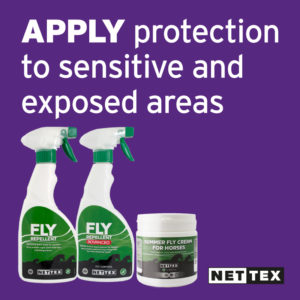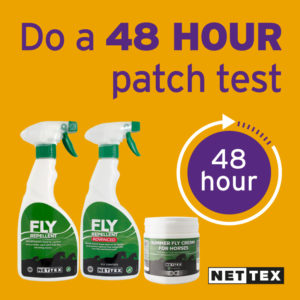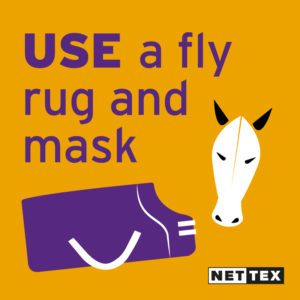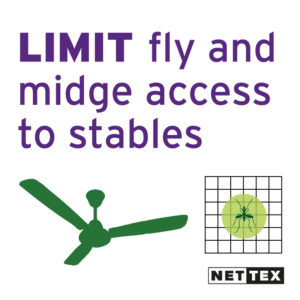Top Tips for Equine Fly Control
Top Tips for Equine Fly Control
By Dr Jim Rawlinson, BVMS MBA MRCVS
Start fly preparations early 
Get the upper hand against flies and midges and start your fly protection methods early. Some flies are active as early as March, and being prepared ahead of time helps reduce the burden these unwelcome visitors cause to your horse or pony.
Establish appropriate shelter, grazing and husbandry protocols before flies arrive, and ensure fly rugs and masks are worn before the midges start to bite. Acting before your horse or pony is itching and bothered really helps control the impact these pesky pests have.
Apply protection to sensitive and exposed areas 
The face and ears are highly reactive to midge bites and taking care of these areas requires careful thought and often multiple modes of protection. A physical barrier, such as a fly mask, which covers the ears and part of the face, is effective and helps protect the eyes, which flies are drawn to. Topical solutions, such as Nettex Equine Summer Freedom can be applied to the external areas of the ears, and face, including the muzzle as a repellent. Do not apply to sunburnt areas on the muzzle.
Don’t forget the sensitive skin around the sheath, belly and sensitive area behind elbows too. Often harder to shield with rugs, regular appliance of a repellent such as Nettex Equine Fly Repellent Advanced or Nettex Equine Fly Repellent Standard, helps deter flies from landing on delicate skin.
Do a 48-hour patch test 
Ingredients used in fly repellents are well tolerated by horses and ponies, but even so, for any new product you use, a patch test is advised. This reduces the risk of your horse and pony having a widespread adverse reaction to any product. To perform a patch test, apply the product to a small area of skin and leave for 48 hours, then check for any form of reaction before continuing use.
Wash your horse or pony regularly
Sweat, urine, faeces – flies can’t help but be attracted to these aromas. Regular washing of your horse and pony to remove such attractants can help remove your horse from being a prime target for flies. Make sure to wash your horse after exercise, or on hot days, and wash off any stable stains thoroughly. Best in Test, Award Winning, Nettex Equine Everyday Conditioning Shampoo is ideal for keeping your horse or pony clean and smelling fresh.

Ensure good HYGIENE
Ensure good stable and yard hygiene. Stables should be mucked out daily and paddocks poo-picked each day as regularly removing soiled bedding removes the appealing odour of urine and clearing faeces reduces the breeding site for many flies. It is also important to keep the manure pile some distance from the stable yard to reduce contact of flies and horses.
Avoid grazing near rivers and streams 
If possible, try to keep your horse’s grazing away from rivers, streams and damp, wet areas. Such places have higher populations of flies and midges, as they tend to gather over water sources. Both horseflies and midges lay their eggs in water and damp vegetation, making it an ideal breeding ground for these annoying critters.
Removing your horse and pony from these areas can dramatically help to reduce their exposure to midges and flies.
Aim for high ground, where possible
Flies like damp areas with no natural airflow, so providing the opposite as an environment for your horse helps deter unwelcome pests. High ground is generally more exposed, with greater airflow and movement, and less likely to be near standing water – an altogether less appealing environment for flies, making it a perfect place for your horse and pony to avoid them.
Fly fact: midges have tiny wings so they struggle to fly in winds above 7mph.
Take extra care at dusk and dawn
Whilst midges can bite at any time, swarms of adult midges are particularly active at dawn and dusk. Extra precautions around these times, such as ensuring fly rugs/masks are worn and correctly secured, removing horses and ponies from areas close to water, and applying repellents, should be carried out.
Use a fly rug and mask 
Take care if applying creams or sprays under fly rugs and masks. In very hot weather horses often sweat under rugs and masks which may lead to a reaction. Apply fly sprays to the outer of the rug to help deter flies and midges from landing on them. When fitted correctly, rugs and masks provide an effective physical barrier against flies. To deter flies further, choose a fly rug that is striped or spotted, and is bright white in colour. Flies are attracted to polarized light, but such rugs reflect this light, making it less attractive for flies. Another important thing to remember is to keep rugs and masks clean, urine and faeces free as flies and midges love these aromas. If this is difficult to manage try having a wash and a wear to give yourself more time between washes and to ensure your horse is never without a rug on laundry days. Remember that midges happily fly into stables (unlike horseflies who don’t like shade), so fly rugs should still be worn when your horse or pony is housed as well as in the field.
Limit fly and midge access to stables 
Midges and some flies will follow your horse or pony into their stable, but there are steps you can take to limit their access. Firstly, keep stables clean and dry, removing urine and faeces regularly, to make the area less appealing to flies. Generally, flies prefer areas with no natural airflow so providing good airflow where possible through barns and stables, or even a fan if your horse or pony will tolerate it, can help to reduce flying visitors. If your horse gets plenty of time out in the field socialising, then fly nets can also be used on stable doors when your horse or pony is housed to limit fly and midge access. You can also use nature’s own defense system and use natural predators to control the fly burden. Although many people discourage Swallows and House Martins from nesting in stables, they consume fly eggs and larvae, so are quite handy to have around.
Check out the Nettex Equine Fly Control range today.
Top Tips for Equine Fly Control
By Dr Jim Rawlinson, BVMS MBA MRCVS
Start fly preparations early 
Get the upper hand against flies and midges and start your fly protection methods early. Some flies are active as early as March, and being prepared ahead of time helps reduce the burden these unwelcome visitors cause to your horse or pony.
Establish appropriate shelter, grazing and husbandry protocols before flies arrive, and ensure fly rugs and masks are worn before the midges start to bite. Acting before your horse or pony is itching and bothered really helps control the impact these pesky pests have.
Apply protection to sensitive and exposed areas 
The face and ears are highly reactive to midge bites and taking care of these areas requires careful thought and often multiple modes of protection. A physical barrier, such as a fly mask, which covers the ears and part of the face, is effective and helps protect the eyes, which flies are drawn to. Topical solutions, such as Nettex Equine Summer Freedom can be applied to the external areas of the ears, and face, including the muzzle as a repellent. Do not apply to sunburnt areas on the muzzle.
Don’t forget the sensitive skin around the sheath, belly and sensitive area behind elbows too. Often harder to shield with rugs, regular appliance of a repellent such as Nettex Equine Fly Repellent Advanced or Nettex Equine Fly Repellent Standard, helps deter flies from landing on delicate skin.
Do a 48-hour patch test 
Ingredients used in fly repellents are well tolerated by horses and ponies, but even so, for any new product you use, a patch test is advised. This reduces the risk of your horse and pony having a widespread adverse reaction to any product. To perform a patch test, apply the product to a small area of skin and leave for 48 hours, then check for any form of reaction before continuing use.
Wash your horse or pony regularly
Sweat, urine, faeces – flies can’t help but be attracted to these aromas. Regular washing of your horse and pony to remove such attractants can help remove your horse from being a prime target for flies. Make sure to wash your horse after exercise, or on hot days, and wash off any stable stains thoroughly. Best in Test, Award Winning, Nettex Equine Everyday Conditioning Shampoo is ideal for keeping your horse or pony clean and smelling fresh.

Ensure good HYGIENE
Ensure good stable and yard hygiene. Stables should be mucked out daily and paddocks poo-picked each day as regularly removing soiled bedding removes the appealing odour of urine and clearing faeces reduces the breeding site for many flies. It is also important to keep the manure pile some distance from the stable yard to reduce contact of flies and horses.
Avoid grazing near rivers and streams 
If possible, try to keep your horse’s grazing away from rivers, streams and damp, wet areas. Such places have higher populations of flies and midges, as they tend to gather over water sources. Both horseflies and midges lay their eggs in water and damp vegetation, making it an ideal breeding ground for these annoying critters.
Removing your horse and pony from these areas can dramatically help to reduce their exposure to midges and flies.
Aim for high ground, where possible
Flies like damp areas with no natural airflow, so providing the opposite as an environment for your horse helps deter unwelcome pests. High ground is generally more exposed, with greater airflow and movement, and less likely to be near standing water – an altogether less appealing environment for flies, making it a perfect place for your horse and pony to avoid them.
Fly fact: midges have tiny wings so they struggle to fly in winds above 7mph.
Take extra care at dusk and dawn
Whilst midges can bite at any time, swarms of adult midges are particularly active at dawn and dusk. Extra precautions around these times, such as ensuring fly rugs/masks are worn and correctly secured, removing horses and ponies from areas close to water, and applying repellents, should be carried out.
Use a fly rug and mask 
Take care if applying creams or sprays under fly rugs and masks. In very hot weather horses often sweat under rugs and masks which may lead to a reaction. Apply fly sprays to the outer of the rug to help deter flies and midges from landing on them. When fitted correctly, rugs and masks provide an effective physical barrier against flies. To deter flies further, choose a fly rug that is striped or spotted, and is bright white in colour. Flies are attracted to polarized light, but such rugs reflect this light, making it less attractive for flies. Another important thing to remember is to keep rugs and masks clean, urine and faeces free as flies and midges love these aromas. If this is difficult to manage try having a wash and a wear to give yourself more time between washes and to ensure your horse is never without a rug on laundry days. Remember that midges happily fly into stables (unlike horseflies who don’t like shade), so fly rugs should still be worn when your horse or pony is housed as well as in the field.
Limit fly and midge access to stables 
Midges and some flies will follow your horse or pony into their stable, but there are steps you can take to limit their access. Firstly, keep stables clean and dry, removing urine and faeces regularly, to make the area less appealing to flies. Generally, flies prefer areas with no natural airflow so providing good airflow where possible through barns and stables, or even a fan if your horse or pony will tolerate it, can help to reduce flying visitors. If your horse gets plenty of time out in the field socialising, then fly nets can also be used on stable doors when your horse or pony is housed to limit fly and midge access. You can also use nature’s own defense system and use natural predators to control the fly burden. Although many people discourage Swallows and House Martins from nesting in stables, they consume fly eggs and larvae, so are quite handy to have around.
Check out the Nettex Equine Fly Control range today.










